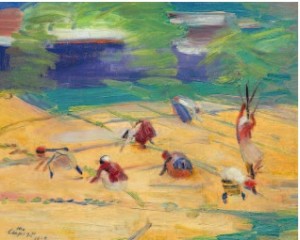Realizing that culture is a realm in which an unlimited number of languages can simultaneously coexist was one of the main characteristics of art after the avant-garde era, which had to deal
c with the world of the early 1920s. This was a world that had just come out of wars, revolutions, massive social upheavals and astronomical losses of human life. Having survived the catastrophes of the previous decade, European culture was once again reviving on the threshold of a new era in its long history.
The period following 1918 is thus called the post-avant-garde period of modern Russian art. The post-avant-garde did not oppose the avant-garde and did not reject its attainments; however, it no longer accepted the avant-garde as either the apex, the collapse, or the final limit of European culture. The 1920s interpreted the avant-garde as merely a link in the chain of connections and changes which comprise the ever unfinished History of Art, a history that is open to the future and that has lost its linear form. Maybe this means that one of the avant-garde’s missions was successful and that the history of art was becoming free of the hierarchy that had at one time existed in it? Maybe it shows that the avant-garde was a good school of modern painting?
The art of the twenties and thirties remained to a significant degree students’ art simply because a large portion of the work was carried out in educational establishments. Yet, it can also be said that this art had just as large a component of exploration and experimentation, for it created an environment for getting to know and understand culture and revealed itself as a tool for the world and as a place in which the new man can appear.
[1] A.G. Gabrichevsky. Morfologiya iskusstva [the Morphology of Art]. M.: Agraf. 2002. P. 25.
[2] O.E. Mandeistam. Shum vremeni [the Noise of Time]. SPb.: Azbuka Klassiki, 2007. P. 192.
[3] Ya.A. Tugendhold. Iskusstvo oktyabrskoy epokhi [the Art of the October Revolution Era]. 1930. Cited in Borba za realizm v izobrazitelnom iskusstve 20-kh godov: materialy, dokumenty, vospominanya [The Struggle for Realism in visual Arts in the 1920s: Materials, Documents, Memoirs]. M.: Sovetsky Khudozhnik, 1962. Pp. 332—333.
[4] Makovets. 1922—1926. Sbornik marerialov po istorii obiyedineniya [Collection of Materials on the History of the Makovets Society: 1922—1926]. M.. 1994. P. 73.
[5] O.E. Mandelstam, p. 196.
[6] Gosudarstvennyi Russkiy muzei predstovlyaet: Aleksandr Lobas. Vospominaniya [The state Russian
Museum Presents: Alexander Labas. Memoirs] / Alrnanakh Almanac], no. 86. SPb.: Palace Editions, 2004. P. 128.



